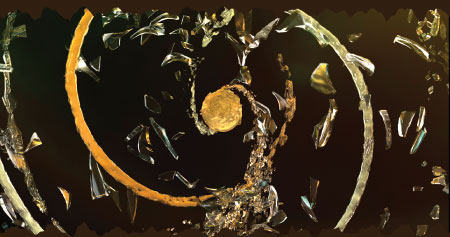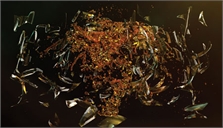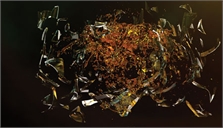In the spirit of the moment, a cognac vendor capitalizes on the 3D revolution to emphasize its message.

Some preconceptions are difficult to shake. When most people think of cognac, they visualize older gents relaxing in well-worn, overstuffed leather chairs while sipping the liquor from a heavy lead-crystal glass in one hand and an expensive cigar in the other. Perhaps that was an accurate depiction from days of old. But today, the picture is far different.
And that is just what Maxxium wanted to show. When Maxxium, which owns Courvoisier cognac, wanted to update its brand and reconnect the spirit of Courvoisier with its cocktail heritage, it hired integrated marketing agency White Label to do just that. With the help of production company Atticus Finch, they set out to shatter that image—literally and metaphorically—in an advertising spot that was shown in stereoscopic 3D.



After discovering that a broadcast network in the UK was devoting a week of 3D TV programming to stereo and was looking to air advertising spots in stereoscopic 3D, White Label suggested that Maxxium present the cognac in another dimension. Maxxium was sold.
The idea pitched to Maxxium was a contemporary spot that would broaden Courvoisier’s appeal outside the stereotypical cognac consumer as a spirit served with a mixer. The focus would be an exploding brandy balloon that reforms into a cocktail—a simple, straightforward visual presentation. Accomplishing it, however, was less than simple. And the only way to maintain the necessary control over the explosion and fluid would be through the use of photoreal computer graphics.
“The project was new and exciting territory for us all: our first TV spot, the first UK TV commercial for Courvoisier, and broadcast on the first-ever night to screen 3D advertising on terrestrial TV,” says White Label’s creative director Greg Saunders.
The ad agency approached Atticus Finch, known for its animation work on videos for the Northern Irish alternative rock band Snow Patrol. Excited about the project, the production company signed on.
Breaking the Model
When Atticus Finch decided that the best route for the commercial would be entirely CG, the production company looked at doing all the work in-house, says Chris Richmond, the facility’s creative director. But soon after, Atticus Finch brought on Spectre VFX for the CG creation, having partnered with that studio on prior projects.
First, Richmond created a static previsualization to communicate Atticus Finch’s vision for the spot that he subsequently handed over to Spectre. A basic animation test within Autodesk’s Softimage provided a taste of the type of movement he wanted for the camera and helped establish the timing of the piece.
Working within Autodesk’s Maya, the group at Spectre modeled all the props, including the cocktail glass and bottle, and textured them, taking care with the caustics, which proved tricky because of the transparent glass. Then they were shattered into tiny pieces.
The artists created the simulation of the explosion using a combination of Maya and Blast Code’s demolition software, a plug-in to Maya. “It took a number of iterations to get the glass simulation correct,” Richmond points out.
The liquid, meanwhile, was simulated using Next Limit Technologies’ RealFlow. Once again, several simulation attempts were needed before the fluid performed the way the director and client wanted for the desired look.
To render the images, the group used Mental Images’ Mental Ray within Maya. The spot called for a great deal of rendering passes (highlight, spectral, ID, motion vector, and so forth) that then doubled for the stereo.


Atticus Finch, along with Spectre VFX, modeled a cocktail glass in Maya, and then shattered it using both Maya and Blast Code. The liquid was simulated using RealFlow.
|
Providing Depth
The models were composited into a black background with The Foundry’s Nuke. According to Richmond, Nuke proved an ideal compositing solution, not only because of its well-developed stereo workflow, but also due to the large amount of rendering that resulted.
“We were doing motion blur but only had a prime-time budget, not a feature-film budget, so we couldn’t go to a renderfarm,” Richmond says. “We did tests for a motion-vector pass, and ended up doing motion blur in Nuke rather than at the point of rendering in Maya to save time, and it worked well.”
The artists also added lighting flares to give the CG atmosphere against the black background that was used in the spot. Because the action occurred in black space with no foreground or background objects, it was difficult to mark the Z-axis depth for the stereo.
In terms of the stereoscopy, Spectre used Maya’s built-in stereo camera rigs, with each placed 64mm apart, the average separation of the human eye. “Getting the lenses and cameras set up to get the best stereo effect took a bit of experimentation. There are limits to where the effects work or don’t work,” says Richmond.
Cheers!
From his point of view, the most challenging aspect of the project, maintains Richmond, was getting the glass fragments to look right with the lighting and the fluid to move in a way that was satisfactory to everyone involved.
Another consideration was the fact that the commercial had complex camera moves but retained a “one-shot” look so that the eye did not have to readjust to new scenes.
To review the stereo effects, the group used anaglyph glasses.
For the broadcast, the group delivered the rendered material to a company for Colorcode encoding, to make it stereo-ready. The commercial also was rendered out in HD and shown in theaters as a preview before Avatar in the UK. In both instances, the audience members, wearing 3D glasses, see a tranquil glass of cognac explode, with glass splinters and liquid flying toward them, before spinning into a vortex that forms a cocktail sitting next to a bottle of Courvoisier.
“We challenged White Label to deliver an innovative campaign to drive reconsideration of Courvoisier as a mixable spirit, and felt the 3D TV commercial opportunity was a great fusion of message and media,” says Eileen Livingston, Maxxium’s marketing controller. “Clearly showcasing Courvoisier as a cognac with another dimension is also a perfect fit with the revolutionary spirit embodied by the brand for the past two centuries.”